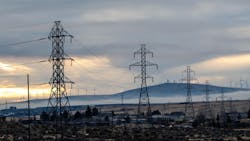DOE’s PNNL Report: Transmission and Renewables Expected to Reduce Carbon Emissions, Generation Costs in Western U.S.
According to results of a report, the Western Interconnection Baseline Study, by the Department of Energy’s Pacific Northwest National Laboratory (PNNL), CO2 emissions are expected to decrease by 73 percent by 2030 as compared to 2005 in the Western U.S., provided all the high-voltage transmission under construction and in advanced stages of permitting is built by 2030, enabling the construction of new renewable energy projects.
The report also showcased that energy generation costs will drop 32 percent by 2030, compared to a reference case where most of these projects are not built. The report is part of the National Transmission Planning Study, funded by DOE’s Grid Deployment Office.
“The Western Interconnection Baseline Study uses the grid industry’s most reliable data to look at how future transmission and renewable energy projects would lower carbon emissions and save money, all while keeping the western grid stable and reliable,” said Konstantinos Oikonomou, a staff power systems research engineer at PNNL and lead author of the study.
The research team built a model of the Western Interconnection including 12 transmission projects currently in advanced stages of development or permitting to study the impacts of new transmission and renewables. The projects are expected to add more than 3,000 miles of new transmission, connecting places like Wyoming to southern California, Nevada and western Arizona.
The researchers also added the possible wind and solar power projects as well as energy storage systems to be built utilizing this new transmission capacity. The Western Interconnection hosts 30 GW of wind power, 38 GW of solar power and 14 GW of energy storage as of July 2024, while the report’s development is anticipated to add an additional 35 GW of wind, 31 GW of solar and 12 GW of energy storage by 2030.
The researchers replicated a typical year of energy demand and generation with the help of their new model of a Western Interconnection having more transmission and 68 more GW of renewable energy.
The simulation included realistic conditions with electricity demand and generation dropping and increasing due to time of day, temperature and weather conditions. The researchers also noticed the cost of energy generation and transportation fluctuating over the year.
The report noted that new transmission lines in the Southwest will allow California to import wind energy from windy areas in New Mexico and Wyoming.
Researchers wanted to find out if this hypothetical future Western Interconnection is capable of dealing with a significant failure and considered two scenarios: a loss of power generation and a loss of power transmission.
While in the first emergency scenario, an Arizona nuclear plant loses two generating units, equivalent of two to three large thermal power plants, in the second emergency scenario, a transmission line delivering 3,100 MW from southern Oregon to northern California fails.
The researchers found that on a grid with a high proportion of renewables, energy storage systems will provide required stability to support the grid against a large generation loss. On the other hand, the grid remains stable with the new transmission lines supporting the existing network, which can reroute power through alternative paths.
The report supports DOE’s National Transmission Planning Study (NTP), which investigates different transmission expansion scenarios and offers recommendations to policymakers. The Western Interconnection Baseline Study acts as a base case for the models used in the NTP study, which is scheduled to be published by the end of 2024.
The NTP study, led by DOE’s Grid Deployment Office and in partnership with PNNL and the National Renewable Energy Laboratory, aims to identify transmission options providing broad-scale benefits to electric customers, inform regional and interregional transmission planning processes and identify interregional and national strategies to accelerate decarbonization while maintaining system reliability.
The NTP study is complemented by several companion reports, including the Western Interconnection Baseline Study and two previous reports on market and operating practices and interregional renewable energy zones.
